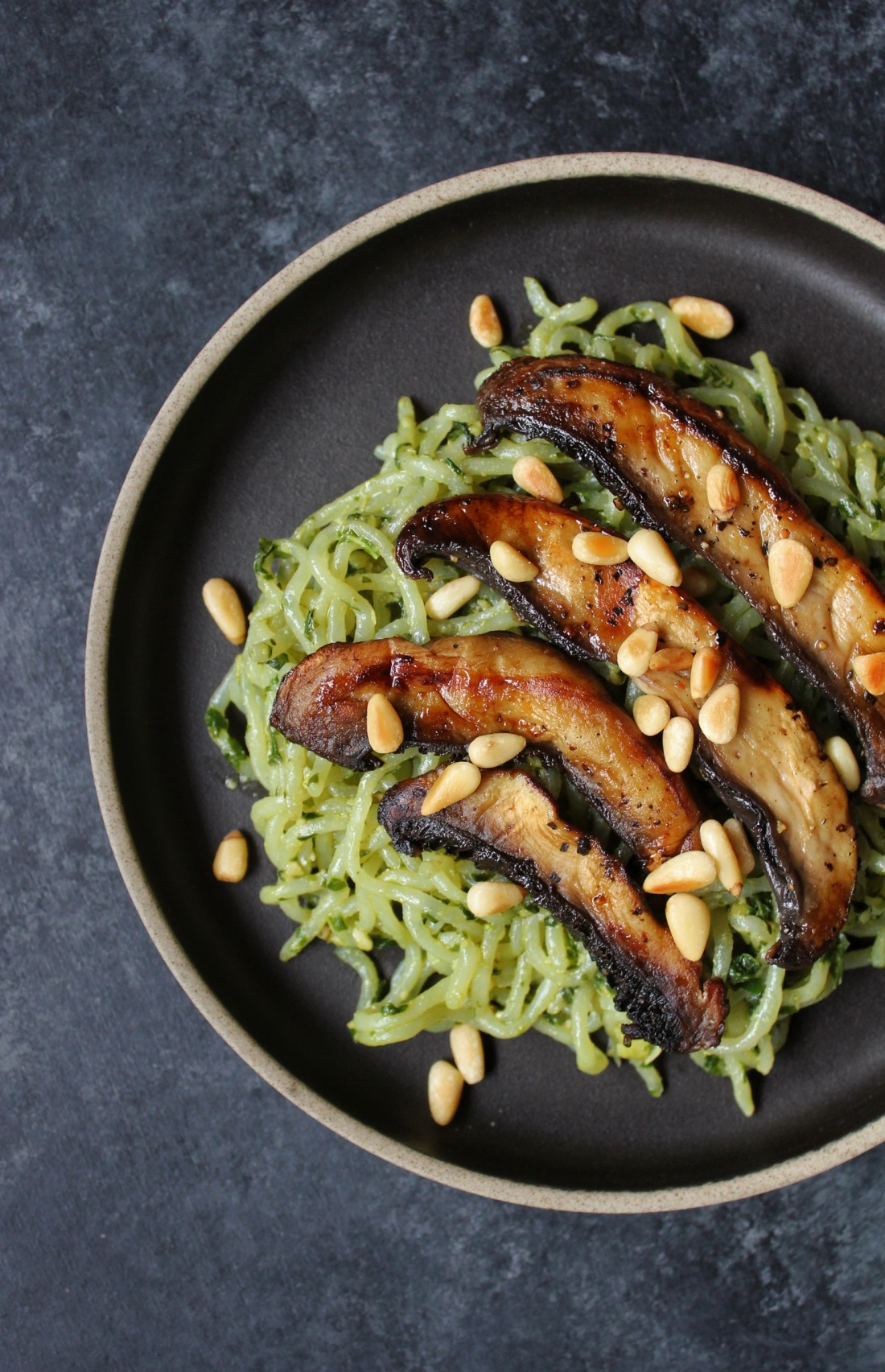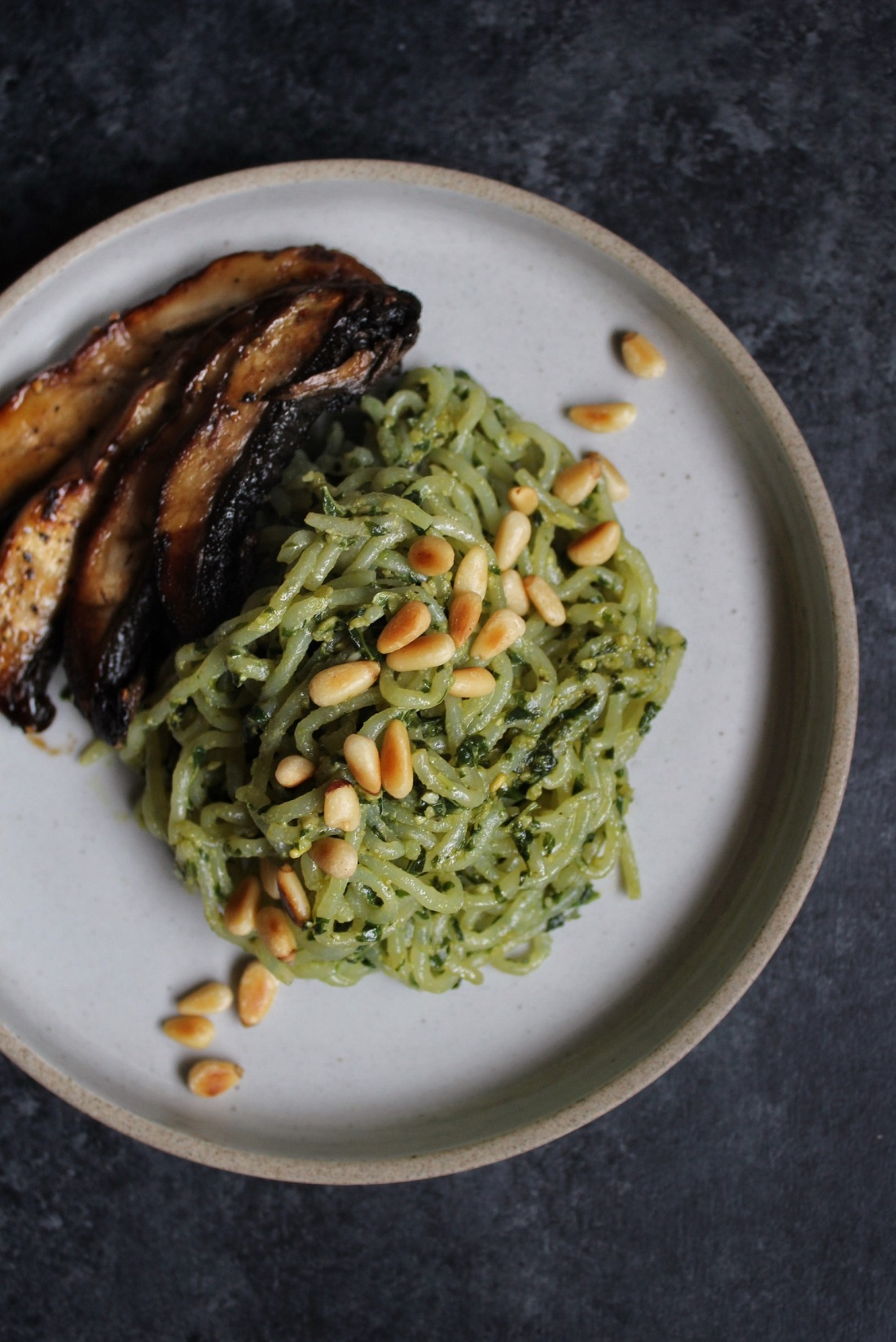You guys said you wanted easy, Plant Paradox-approved meals – we got you fam. We too have been enjoying simple, veggie-based dishes, and this one is no exception: it only requires the use of one pan, it takes 30 minutes to make, and it’s packed with prebiotic fiber, antioxidants from extra virgin olive oil & basil, and healthy fats from ‘lil pine nuts.
Oh, and it’s exploding with flavor.
If you don’t know what typically makes up pesto, it’s a combination of these ingredients: basil, extra virgin olive oil, pine nuts, garlic, salt, parmesan cheese, and *sometimes* lemon juice. Then, to make it, you combine all of the ingredients in a food processor and blend until it’s sorta kinda smooth (it doesn’t have to be a smooth paste). I can hardly claim this pesto recipe as “original,” because it’s pretty much based off of every other pesto recipe out there, the main difference being we replace parmesan with nutritional yeast.

Pesto Pro-Tips:
- Gently pan-roasting the pine nuts before using them adds a robust edge, which is nice.
- Because this involves a whole load of basil leaves, it’s best to use organic, as pesticides are often sprayed right onto conventional basil leaves.
- High quality extra virgin olive is great if you have it, because the more complex/fruity your olive oil is, the better your pesto will come out; but any organic extra virgin olive oil will do the trick.
- Pine nuts pretty much cost a small fortune, so I don’t see it worth it to pay for organic. Plus, pine nuts are incased in not one, but two hard shells during the growing process, making them more resistant to any pesticides that may be sprayed on them. But you can find out a more about these ‘lil seeds here.

Pasta & Pesto is a classic combination that’s worthy of it’s popularity. While semolina wheat pasta is the traditional choice, I see it reasonable that any pasta can work. Coming into a Plant Paradox diet, pasta may seem completely off limits. However, there are a couple of options open to you: tapioca starch pasta (yes, it exists – check an Oriental market), sweet potato starch pasta (a.k.a. japchae noodles), white rice pasta (technically free of lectins, not technically part of the Plant Paradox diet), and shirataki noodles.
All of the aforementioned are great options, however shirataki or “Miracle” noodles may be the healthiest & easiest among the list. Why? Well, for one, they contain practically no carbs or calories. Two, they’re freakin’ packed with prebiotic fiber, meaning your gut bacteria loves it, probiotics will stick around in your system better when you eat them, and your bathroom visits will be cleaner & quicker. Three, they’re cheap – check your local oriental market for them before visiting an American store, as they tend to have bigger bags for less money. Four, they don’t require any boiling – you simply drain them from their packaging liquid and toss them into a frying pan for a few minutes.
Hallelujah! Miracle noodles indeed.
Every dish needs its “cherry on top,” which is why we add some simply seasoned, sautéed portobello mushrooms on top, which adds depth of flavor and a meaty texture. As you’ll see in the recipe, smoked salt or truffle salt add pleasant complexities to this otherwise straightforward dish, so if you’ve got the goods on hand, sprinkle ’em on!
All in all, this dinner is:
- Easy to make, requiring only 30 Minutes & 1 Pan
- Packed with antioxidants, prebiotic fiber, and healthy fats
- Vegan, Grain-Free, Plant Paradox-friendly & Keto-friendly
- Savory, herbal, rich, and Italian-inspired
- Perfect for an easy lunch or dinner for two
If you like what your taste buds are tellin’ ya, leave behind a nice rating, share your thoughts with us in the comments, or show us your creations by tagging @noeggsorham on Instagram.
Go Forth & Devour,
Ryan

1-Pan Shirataki Pesto Bowl w/ Sautéed Portobello Mushrooms (Vegan, Keto & Plant Paradox-friendly)
Deep & savory flavors, chewy & rich textures, and lots & lots of antioxidants.
Ingredients
Pesto
- 2 c (80 g) packed basil leaves*
- 3 medium garlic cloves, roughly chopped
- 3 tbsp pine nuts
- 3 tbsp nutritional yeast
- 3 tbsp extra virgin olive oil (plus more if needed)
- 1 tbsp lemon juice
- 1/2 tsp salt
Sautéed Portobello
- 1 large portobello cap, cut into 1/2 inch slices
- olive oil
- lemon juice
- salt (smoked or truffle salt if you have it)
- black pepper
Pasta
- 1 14 oz package shirataki noodles
- 1/4 c pesto
- 1 tbsp extra virgin olive oil
- small pinch if salt
Optional Toppings
- 2 tbsp toasted pine nuts (show in photos)
- vegan parmesan
- nutritional yeast
Directions
- Pesto: Heat a medium-large (11-12 in) sauté pan over medium heat. Once hot, add in 5 tablespoons of pine nuts. Toast, frequently shaking the pan, until they’re lightly browned; about 2 minutes. Set aside.
- Into the bowl of a food processor, add 3 tablespoons of toasted pine nuts – reserve the other 2 tablespoons for topping – plus the rest of the pesto ingredients. Blend on low, scraping down the sides with a spatula once or twice, until the mixture forms a loose paste.
- There should be little bits of basil & pine nuts in the pesto; don’t blend it into a completely smooth paste.
- Pasta: Drain liquid from shirataki noodles and rinse in a fine mesh strainer for a few seconds. Place noodles on a cutting board, gather them together into a clump, and cut them into three sections to make shorter noodles.
- Place the same pan from before over medium-high heat. Once hot, add in noodles and cook for two minutes.
- Add in olive oil, 1/4 cup of pesto, and a small pinch of salt. Cook, stirring frequently, until thoroughly heated; about three minutes. Transfer pasta to two bowls or plates and set aside for now.
- Mushrooms: Drizzle portobello mushroom slices with enough olive oil & lemon juice to coat and sprinkle generously with pepper and salt.
- Heat same sauté pan over medium-high heat. Once hot, add mushroom slices and cook on each side until golden brown; 2-3 minutes per side. Distribute atop pasta bowls.
- Topping: Top with additional toasted pine nuts, vegan parmesan, or nutritional yeast and serve! Best while warm, although leftovers can be stored in the fridge for up to 3 days. Reheat in a pan over medium heat until hot.
- Store pesto in an airtight container in the fridge for up to a week and a half. It’s great on roasted veggies, toast, and always – more pasta.
*Use only the leaf part of the basil; stems don’t exactly make good pesto.
OK, our version didn’t look as wow as this, but it was very tasty. We had spinach-infused shirtataki noodles here and maybe used toomuch lemon juice, however, this was a super recipe and we will definitely be making it again! And so quick too!
Thanks a million guys for the many great ideas! 😊
LikeLike